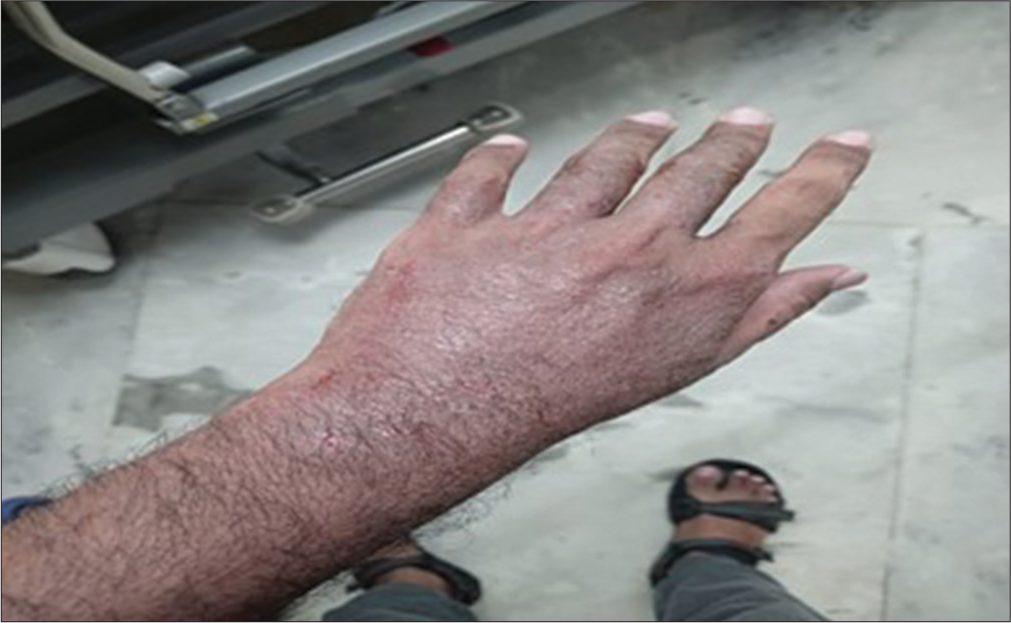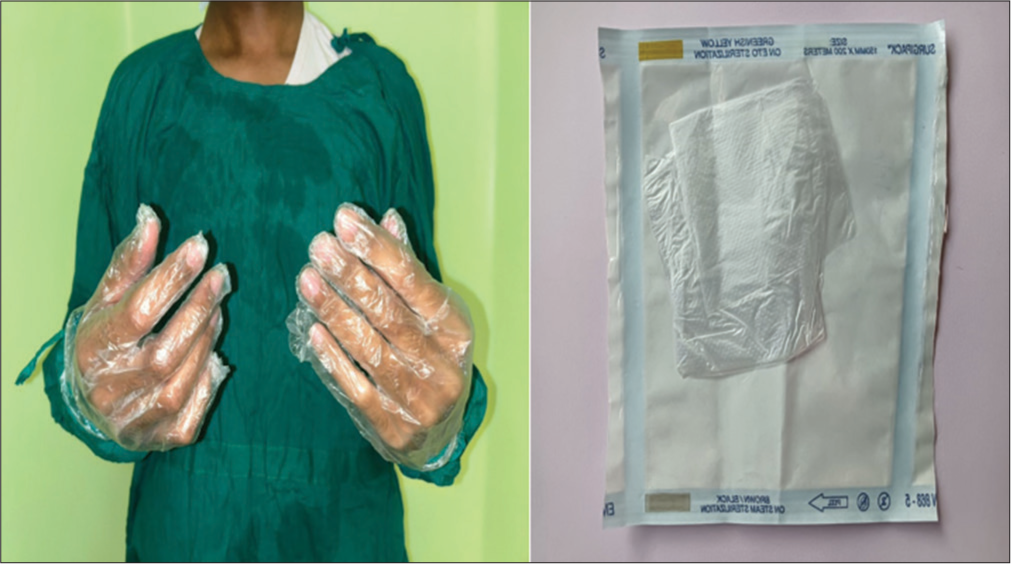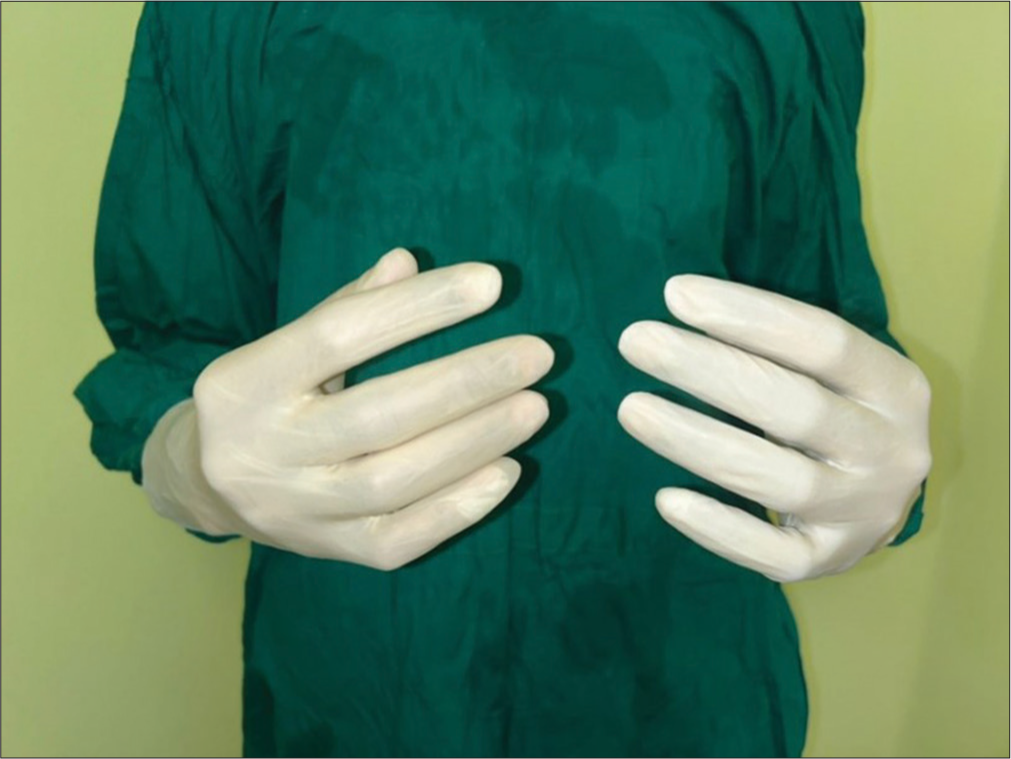Translate this page into:
Cost-effective method to prevent latex allergy in healthcare workers

*Corresponding author: Ravi Kumar Chittoria, Department of Plastic Surgery, Jawaharlal Institute of Postgraduate Medical Education and Research, Puducherry, India. drchittoria@yahoo.com
-
Received: ,
Accepted: ,
How to cite this article: Chittoria RK, Barath Kumar Singh P, Pola V. Cost-effective method to prevent latex allergy in healthcare workers. CosmoDerma 2023;3:171. doi: 10.25259/CSDM_217_2023
PROBLEM
Latex allergies are caused by proteins in rubber tree latex. Latex allergies cause the body to confuse latex for a dangerous allergic chemical. Latex allergy can cause itchy skin, hives, or anaphylaxis, a life-threatening condition that causes throat swelling and difficulty in breathing.[1,2] Healthcare personnel must use latex gloves. Non-latex gloves were expensive and scarce in some places. Chemical antibodies can induce allergic contact dermatitis. Usually, only the allergen-exposed area of hands is affected. Food, flavorings, drugs, dentistry, and medical procedures can cause it. Most often contact dermatitis is of this type.[3] Allergic contact dermatitis can arise from acute or chronic toxic insults.[3] Chemical or physical irritants can also cause it. Hairdressers, nurses, cooks, and mothers of small infants are at risk of contact dermatitis due to their frequent water exposure. Chemical irritant contact dermatitis is usually caused by strong or mild irritants.[4,5] When a chemical is applied repeatedly to the same skin location, it causes erythema, edema, or corrosion. Toxins operate differently. Detergents, surfactants, pH extremes, and organic solvents directly affect epidermal barrier function. These effects include fat emulsion removal, epithelial cell injury, and increased transepidermal water loss due to DNA damage and horny layer water-binding disruption, which thins the layer. Strong irritating concentrations have an initial effect, but irritants’ cumulative, chronic effects worsen with repeated exposures.[6,7] Solvents, metalworking fluids, latex, kerosene, ethylene oxide, surfactants (like sodium lauryl sulfate) in topical medications and cosmetics, and alkalies (like drain cleaners and strong soap with lye residues) are common chemical irritants. A complete patient history and negative allergy patch testing are usually needed to diagnose.
SOLUTION
In this case report, the patient is a 25-year-old male patient, who joined as a surgery resident, found to be diagnosed with stage II allergic contact dermatitis syndrome to latex surgical gloves [Figure 1]. He developed erythema and multiple papular lesions with urticaria surrounding the lesion. He was treated initially by avoiding latex gloves and standard protocol. After that, the surgery resident found difficulty in finding the non-latex gloves in the hospital, as the supply was very limited and costly. He wore sterilized polythene transparent gloves first, then the latex gloves to prevent direct contact with the skin [Figures 2 and 3]. This method helps in prevention of contact dermatitis effectively. The cost of a polythene transparent glove is 50 Indian rupees/50 pairs of gloves. The patient never developed allergic contact dermatitis with this method. He was able to undergo surgical residency successfully without using non-latex gloves. No complications were noted with these polythene gloves.

- Allergic contact dermatitis over dorsal surface of the hand.

- Transparent sterilized polythene glove.

- Latex glove worn over transparent sterilized polythene glove.
The use of transparent polythene gloves was found to be effective in preventing allergic contact dermatitis. This method can be easily adopted and can be used in any center.
Declaration of patient consent
The authors certify that they have obtained all appropriate patient consent.
Conflicts of interest
There are no conflicts of interest.
Use of artificial intelligence (AI)-assisted technology for manuscript preparation
The authors confirm that there was no use of artificial intelligence (AI)-assisted technology for assisting in the writing or editing of the manuscript and no images were manipulated using AI.
Financial support and sponsorship
Nil.
References
- Latex allergy in clinical practice. Indian J Dermatol. 2012;57:66-70.
- [CrossRef] [PubMed] [Google Scholar]
- Latex allergies: A review of recognition, evaluation, management, prevention, education, and alternative product use. J Athl Train. 2003;38:133-40.
- [Google Scholar]
- Differentiation of latex allergy from irritant contact dermatitis. Cutis. 2015;96:369-71, 401
- [Google Scholar]
- Latex allergy: Diagnosis and management. Dermatol Ther. 2004;17:289-301.
- [CrossRef] [PubMed] [Google Scholar]
- Allergen component analysis as a tool in the diagnosis and management of occupational allergy. Mol Immunol. 2018;100:21-7.
- [CrossRef] [PubMed] [Google Scholar]
- Current prevalence rate of latex allergy: Why it remains a problem? J Occup Health. 2016;58:138-44.
- [CrossRef] [PubMed] [Google Scholar]





